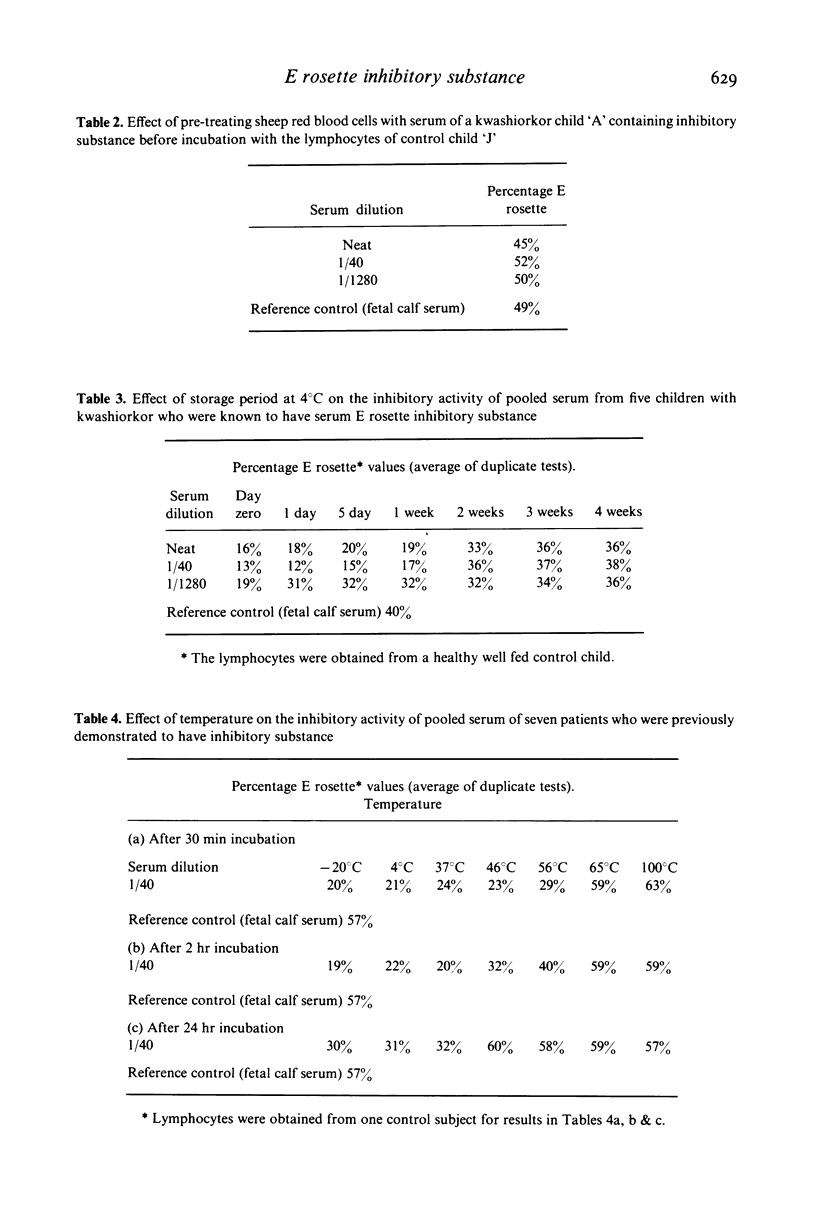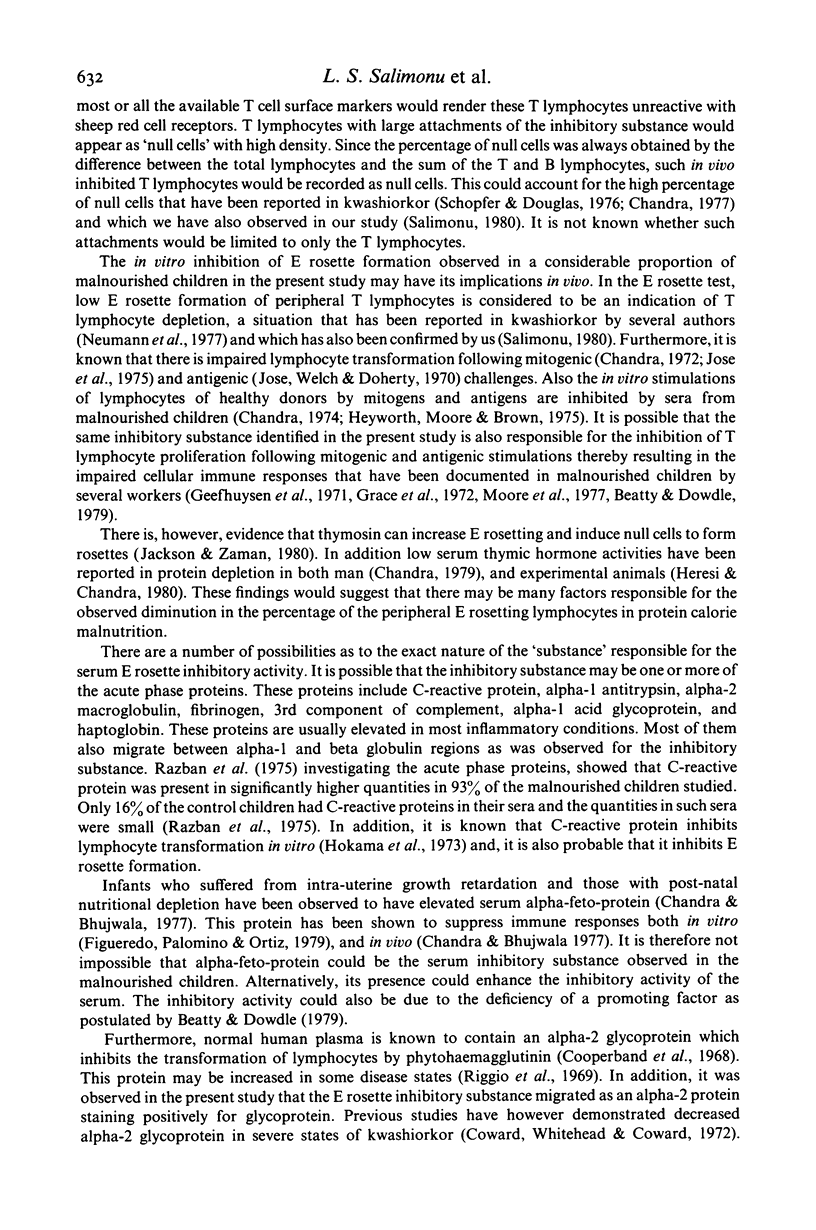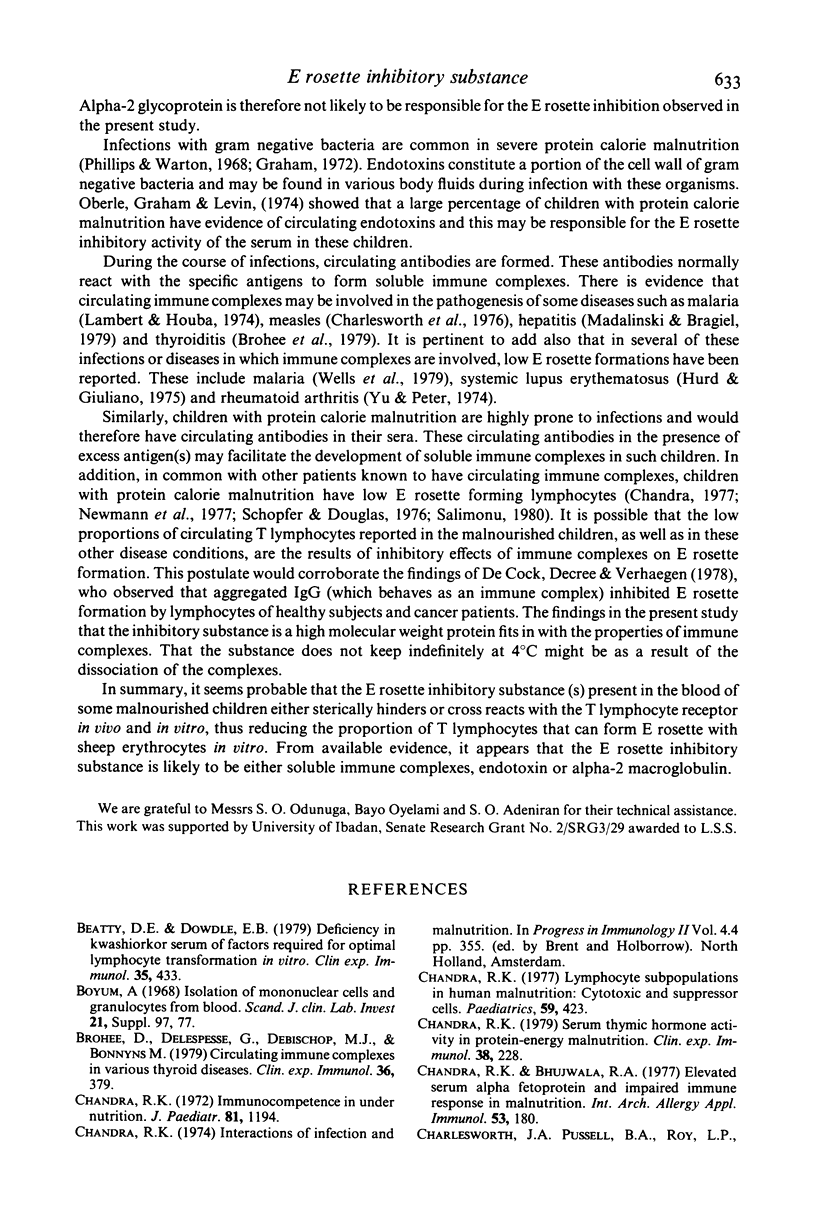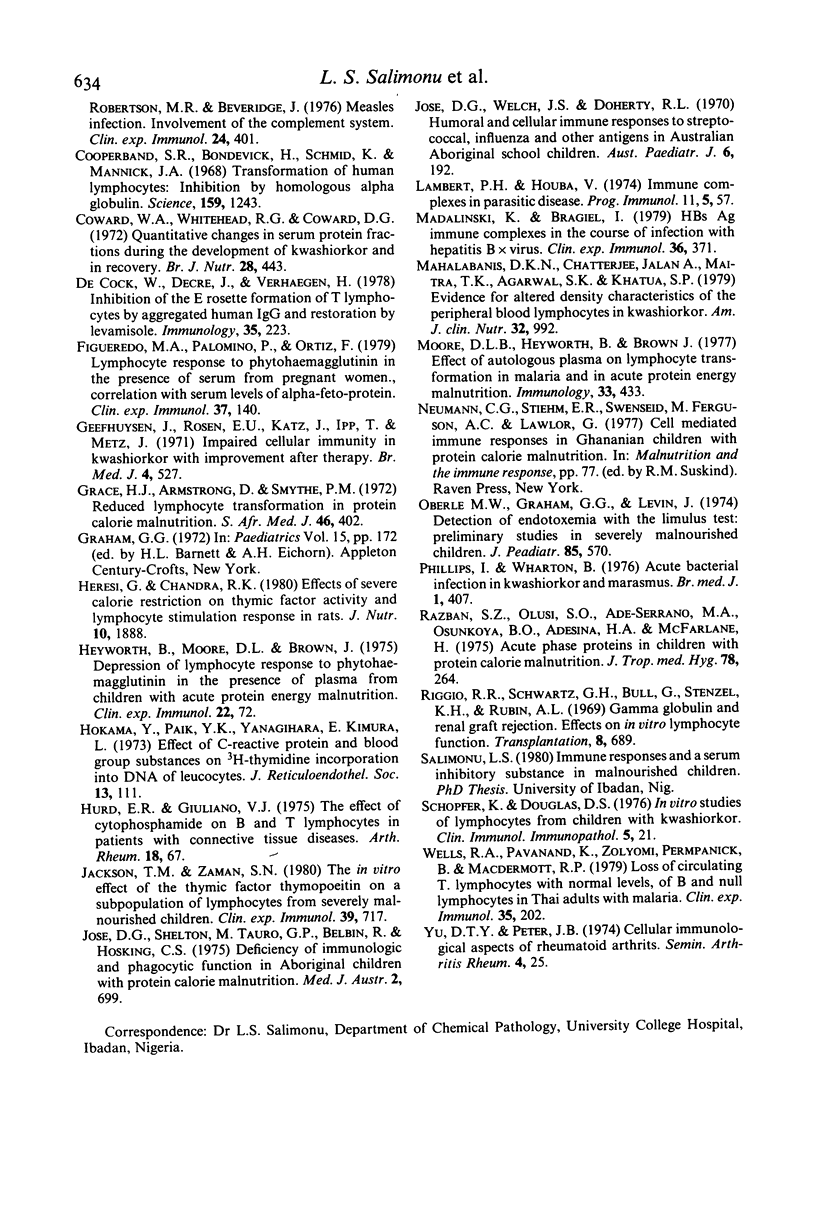Abstract
In vitro sheep erythrocyte (E) rosette inhibitory activity was observed in the sera of nine out of 22 (41%) children with kwashiorkor, three of 15 (20%) marasmic children, neither of the two children with marasmic-kwashiorkor and in one of 42 (2%) well nourished control children. Sera of children with kwashiorkor containing the E rosette inhibitory substance did not inhibit in vitro rosette formations by autologous lymphocytes whereas rosette formations by homologous lymphocytes were inhibited. Inhibition of E rosette formation occurred when lymphocytes were pretreated with serum having the inhibitory substance before incubation with sheep red cells, but there was no such inhibition when sheep red cells were pretreated with the same serum before incubation with lymphocytes. The inhibitory substance was observed to be stable at 4 degrees C up to about 1 week and migrated electrophoretically with the alpha-2 globulins. It was digested by papain. It is probable that the E rosette inhibitory substance demonstrated in the present study is attached to markers on T lymphocyte surfaces in some malnourished children thereby making the lymphocytes unreactive in vitro and presumably in vivo as well.
Full text
PDF








Selected References
These references are in PubMed. This may not be the complete list of references from this article.
- Beatty D. W., Dowdle E. B. Deficiency in kwashiorkor serum of factors required for optimal lymphocyte transformation in vitro. Clin Exp Immunol. 1979 Mar;35(3):433–442. [PMC free article] [PubMed] [Google Scholar]
- Brohee D., Delespesse G., Debisschop M. J., Bonnyns M. Circulating immune complexes in various thyroid diseases. Clin Exp Immunol. 1979 Jun;36(3):379–383. [PMC free article] [PubMed] [Google Scholar]
- Chandra R. K., Bhujwala R. A. Elevated serum alpha-fetoprotein and impaired immune response in malnutrition. Int Arch Allergy Appl Immunol. 1977;53(2):180–185. doi: 10.1159/000231749. [DOI] [PubMed] [Google Scholar]
- Chandra R. K. Immunocompetence in undernutrition. J Pediatr. 1972 Dec;81(6):1194–1200. doi: 10.1016/s0022-3476(72)80262-2. [DOI] [PubMed] [Google Scholar]
- Chandra R. K. Lymphocyte subpopulations in human malnutrition: cytotoxic and suppressor cells. Pediatrics. 1977 Mar;59(3):423–427. [PubMed] [Google Scholar]
- Chandra R. K. Serum thymic hormone activity in protein-energy malnutrition. Clin Exp Immunol. 1979 Nov;38(2):228–230. [PMC free article] [PubMed] [Google Scholar]
- Charlesworth J. A., Pussell B. A., Roy L. P., Robertson M. R., Beveridge J. Measles infection. Involvement of the complement system. Clin Exp Immunol. 1976 Jun;24(3):401–406. [PMC free article] [PubMed] [Google Scholar]
- Cooperband S. R., Bondevik H., Schmid K., Mannick J. A. Transformation of human lymphocytes: inhibition by homologous alpha globulin. Science. 1968 Mar 15;159(3820):1243–1244. doi: 10.1126/science.159.3820.1243. [DOI] [PubMed] [Google Scholar]
- De Cock W., De Cree J., Verhaegen H. Inhibition of the E-rosette formation of T-lymphocytes by aggregated human IgG and restoration by levamisole. Immunology. 1978 Aug;35(2):223–227. [PMC free article] [PubMed] [Google Scholar]
- Figueredo M. A., Palomino P., Ortiz F. Lymphocyte response to phytohaemagglutinin in the presence of serum from pregnant women: correlation with serum levels of alpha-foetoprotein. Clin Exp Immunol. 1979 Jul;37(1):140–144. [PMC free article] [PubMed] [Google Scholar]
- Geefhuysen J., Rosen E. U., Katz J., Ipp T., Metz J. Impaired cellular immunity in kwashiorkor with improvement after therapy. Br Med J. 1971 Nov 27;4(5786):527–529. doi: 10.1136/bmj.4.5786.527. [DOI] [PMC free article] [PubMed] [Google Scholar]
- Grace H. J., Armstrong D., Smythe P. M. Reduced lymphocyte transformation in protein calorie malnutrition. S Afr Med J. 1972 Apr 1;46(14):402–403. [PubMed] [Google Scholar]
- Heresi G., Chandra R. K. Effects of severe calorie restriction on thymic factor activity and lymphocyte stimulation response in rats. J Nutr. 1980 Sep;110(9):1888–1893. doi: 10.1093/jn/110.9.1888. [DOI] [PubMed] [Google Scholar]
- Heyworth B., Moore D. L., Brown J. Depression of lymphocyte response to phytohaemagglutinin in the presence of plasma from children with acute protein energy malnutrition. Clin Exp Immunol. 1975 Oct;22(1):72–77. [PMC free article] [PubMed] [Google Scholar]
- Hokama Y., Paik Y. P., Kimura L., Yanagihara E. Effect of C-reactive protein and blood-group substances on 3 H-thymidine incorporation into DNA of leukocyte. J Reticuloendothel Soc. 1973 Feb;13(2):111–121. [PubMed] [Google Scholar]
- Hurd E. R., Giuliano V. J. The effect of cyclophosphamide on B and T lymphocytes in patients with connective tissue diseases. Arthritis Rheum. 1975 Jan-Feb;18(1):67–75. doi: 10.1002/art.1780180113. [DOI] [PubMed] [Google Scholar]
- Jackson T. M., Zaman S. N. The in vitro effect of the thymic factor thymopoietin on a subpopulation of lymphocytes from severely malnourished children. Clin Exp Immunol. 1980 Mar;39(3):717–721. [PMC free article] [PubMed] [Google Scholar]
- Jose D. G., Welch J. S., Doherty P. L. Humoral and cellular immune responses to streptococci, influenza and other antigens in Australian aboriginal school children. Aust Paediatr J. 1970 Dec;6(4):192–202. [PubMed] [Google Scholar]
- Lis M. T., Matthews D. M., Crampton R. F. Effects of dietary restriction and protein deprivation on intestinal absorption of protein digestion products in the rat. Br J Nutr. 1972 Nov;28(3):443–446. doi: 10.1079/bjn19720054. [DOI] [PubMed] [Google Scholar]
- Madaliński K., Bragiel I. HBsAg immune complexes in the course of infection with hepatitis B virus. Clin Exp Immunol. 1979 Jun;36(3):371–378. [PMC free article] [PubMed] [Google Scholar]
- Mahalanabis D., Jalan K. N., Chatterjee A., Maitra T. K., Agarwal S. K., Khatua S. P. Evidence for altered density characteristics of the peripheral blood lymphocytes in kwashiorkor. Am J Clin Nutr. 1979 May;32(5):992–996. doi: 10.1093/ajcn/32.5.992. [DOI] [PubMed] [Google Scholar]
- Oberle M. W., Graham G. G., Levin J. Detection of endotoxemia with the Limulus test: preliminary studies in severely malnourished children. J Pediatr. 1974 Oct;85(4):570–573. doi: 10.1016/s0022-3476(74)80473-7. [DOI] [PubMed] [Google Scholar]
- Phillips I., Wharton B. Acute bacterial infection in kwashiorkor and marasmus. Br Med J. 1968 Feb 17;1(5589):407–409. doi: 10.1136/bmj.1.5589.407. [DOI] [PMC free article] [PubMed] [Google Scholar]
- Razban S. Z., Olusi S. O., Ade-Serrano M. A., Osunkoya B. O., Adeshina H. A., McFarlane H. Acute phase proteins in children with protein-calorie malnutrition. J Trop Med Hyg. 1975 Dec;78(12):264–266. [PubMed] [Google Scholar]
- Riggio R. R., Schwartz G. H., Bull F. G., Stenzel K. H., Rubin A. L. Alpha-2-globulins in renal graft rejection. Effects of in vitro lymphocyte function. Transplantation. 1969 Nov;8(5):689–694. doi: 10.1097/00007890-196911000-00013. [DOI] [PubMed] [Google Scholar]
- Schopfer K., Douglas S. D. In vitro studies of lymphocytes from children with kwashiorkor. Clin Immunol Immunopathol. 1976 Jan;5(1):21–30. doi: 10.1016/0090-1229(76)90146-x. [DOI] [PubMed] [Google Scholar]
- Wells R. A., Pavanand K., Zolyomi S., Permpanich B., MacDermott R. P. Loss of circulating T lymphocytes with normal levels of B and 'null' lymphocytes in Thai adults with malaria. Clin Exp Immunol. 1979 Feb;35(2):202–209. [PMC free article] [PubMed] [Google Scholar]
- Yu D. T., Peter J. B. Cellular immunological aspects of rheumatoid arthritis. Semin Arthritis Rheum. 1974 Fall;4(1):25–52. doi: 10.1016/0049-0172(74)90016-x. [DOI] [PubMed] [Google Scholar]


